Scott,
You are correct. The intention by SY was to connect the positive regulator to one side of the heater and the negative regulator to the other side of the heater. The HMN heater schematic shows a connection to common, but that connection doesn't exist. The total across the voltage across the heaters on the ECC88 should be 6.3 VDC as you noted. Even with that set-up, the regulators are working at a voltage difference from common. Since common is lifted well above ground, noise is reduced from a balanced set-up where common is at ground. At least that's how I understand it.
You are correct about the heater regulator power supply voltage being key in the temperature issue. It would take a good size heatsink for +/- 13 V. Even with a lower voltage transformer, I was happier using a heatsink on the regulators.
Jac
You are correct. The intention by SY was to connect the positive regulator to one side of the heater and the negative regulator to the other side of the heater. The HMN heater schematic shows a connection to common, but that connection doesn't exist. The total across the voltage across the heaters on the ECC88 should be 6.3 VDC as you noted. Even with that set-up, the regulators are working at a voltage difference from common. Since common is lifted well above ground, noise is reduced from a balanced set-up where common is at ground. At least that's how I understand it.
You are correct about the heater regulator power supply voltage being key in the temperature issue. It would take a good size heatsink for +/- 13 V. Even with a lower voltage transformer, I was happier using a heatsink on the regulators.
Jac
Hi jackinnj,
Would it be possible to get a set of boards shipped to England? If so that would be great. Thanks.
Would it be possible to get a set of boards shipped to England? If so that would be great. Thanks.
Thanks Jac;
That makes sense. There would be no reason to run them via the heater common if you were trying to eliminate noise. My heater common is elevated at about 20 volts relative to the B+ supply ground.
I also found that his EO power supply schematic has a small error. The LM337 regulator has pins 2 and 3 swapped. He shows it with the same pinout as the LM 317, but that has pin 3 as input and pin 2 as output. The 337 has pin 2 as input and pin 3 as output. Of course I laid out my board the wrong way..sigh..
I ordered a 2 amp 5 volt CT transformer to replace the 9 volt CT one I have. That should give me about +/-7 volts DC with a bridge rectifier, and only 3.5 volts of overhead, so about a watt of dissipation.
Scott
That makes sense. There would be no reason to run them via the heater common if you were trying to eliminate noise. My heater common is elevated at about 20 volts relative to the B+ supply ground.
I also found that his EO power supply schematic has a small error. The LM337 regulator has pins 2 and 3 swapped. He shows it with the same pinout as the LM 317, but that has pin 3 as input and pin 2 as output. The 337 has pin 2 as input and pin 3 as output. Of course I laid out my board the wrong way..sigh..
I ordered a 2 amp 5 volt CT transformer to replace the 9 volt CT one I have. That should give me about +/-7 volts DC with a bridge rectifier, and only 3.5 volts of overhead, so about a watt of dissipation.
Scott
Scott,
If you haven't already, check post 224 of the Equal Opp thread. I found several little things like voltage regulator pin problem and listed them up in my build notes. Hopefully, that will keep you from some of the mistakes I made.
Jac
If you haven't already, check post 224 of the Equal Opp thread. I found several little things like voltage regulator pin problem and listed them up in my build notes. Hopefully, that will keep you from some of the mistakes I made.
Jac
@mrdave -- pm me -- if you have a paypal account it furnishes a shipping label automatically, but if i have to go to the post office the amount they charge depends on who's pms-ing on the given day...
@mrdave -- pm me -- if you have a paypal account it furnishes a shipping label automatically, but if i have to go to the post office the amount they charge depends on who's pms-ing on the given day...
I think you mean @mrdave45.
(This isn't going to get confusing at all...)
Hi jackinnj,
I took a look to your board an found the resistors to adjust the current.
The 2,7k (20mA), is it prallel to the 120Ohm Resistor?
thank you for your work
I took a look to your board an found the resistors to adjust the current.
The 2,7k (20mA), is it prallel to the 120Ohm Resistor?
thank you for your work
Have a look at the impasse article. There's some info in there about setting the adjust resistor (the values are different as that requires 8mA but the principals the same) . I made the circuit on a breadboard and used a trim pot set up as a variable resistor to trim the current. Once correct I measured the resistance of the trim and parallel fixed resistor and selected fixed resistors to match.
Make sure you use the components in the same place when transferring to the pcb.
Make sure you use the components in the same place when transferring to the pcb.
@frankwilker -- you use a DVM ammeter to set the anode current to 20mAby adjusting the parallel resistor. I use a 10k multi-turn potentiometer and adjust until satisfied, then measure and implant a parallel resistor OR calculate the appropriate value for one resistor.
Has anyone had any experience with enovaz transformers.
Found this:
https://www.enovaz.com/trasformatore-di-alimentazione-secondari-250-0-250v-5v-e-6-3v.html
42 euro
They do one rated at 200mA for 52 euro. I dont know how conservatively they are rated. Would it be better to get the 200mA one or just stick with the 100mA one as 100mA should have enough headroom anyway unless they're complete junk.
Majestic havent got back to me yet but i suspect they would be considerably more expensive as it would be a custom wind.
Found this:
https://www.enovaz.com/trasformatore-di-alimentazione-secondari-250-0-250v-5v-e-6-3v.html
42 euro
They do one rated at 200mA for 52 euro. I dont know how conservatively they are rated. Would it be better to get the 200mA one or just stick with the 100mA one as 100mA should have enough headroom anyway unless they're complete junk.
Majestic havent got back to me yet but i suspect they would be considerably more expensive as it would be a custom wind.
They only had 220v primaries and having spoken to someone local he thought I may find the core saturates. Anyway, found someone who will wind me one so all sorted now.
SUT loading
so, Im having fun and games playing around with the loading.
Ive tried using a balanced sound card but the output has its own ringing so thats not worked too well. Currently using a cheapo usb powered signal generator that does produce a pretty good square wave. Im running that it to the 30k 12R (to match my cart) 30k resistor network to knock the level down. This seems to be working reasonably well.
However, Im finding that higher value of resistors arent damping the ringing enough and i am finding i have to use much higher value caps to stop the ringing and this slows down the rise time too much.
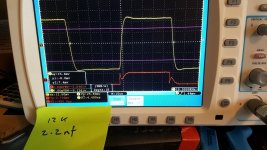
I can get really good square waves with lower value resistors but Im finding its knocking the output of the source down quite a bit more than is ideal. Down 50% where i get the best output shape.
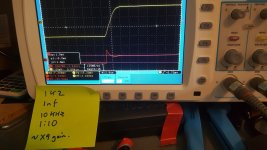
Im also noticing that the more capacitance i put on the load it distorts the input across the 12R resistor. Ive put a scope channel across the source resistor to see whats going on there.
Currently my best compromise seems to be 3K3 with a 2n2F giving me a rise time of 4us and a 2.3db drop. Which is about 23%. But theres still a little bit of overshoot.
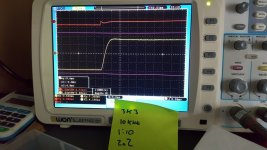
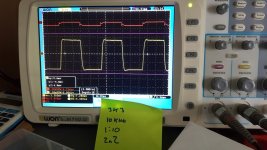
This however loads my cart at 33ohm using 1:10 windings, way lower that the recommended 100R from the benz website.
Anybody got any thoughts on how i choose where to compromise?
Also, does that distorting on the source matter if the output is whats its meant to be? At some loadings there isn't that drop, it just overshoots. Im not surprised that its very interactive but not sure of the effect on cart regarding back emf and goodness knows what else.
so, Im having fun and games playing around with the loading.
Ive tried using a balanced sound card but the output has its own ringing so thats not worked too well. Currently using a cheapo usb powered signal generator that does produce a pretty good square wave. Im running that it to the 30k 12R (to match my cart) 30k resistor network to knock the level down. This seems to be working reasonably well.
However, Im finding that higher value of resistors arent damping the ringing enough and i am finding i have to use much higher value caps to stop the ringing and this slows down the rise time too much.

I can get really good square waves with lower value resistors but Im finding its knocking the output of the source down quite a bit more than is ideal. Down 50% where i get the best output shape.

Im also noticing that the more capacitance i put on the load it distorts the input across the 12R resistor. Ive put a scope channel across the source resistor to see whats going on there.
Currently my best compromise seems to be 3K3 with a 2n2F giving me a rise time of 4us and a 2.3db drop. Which is about 23%. But theres still a little bit of overshoot.


This however loads my cart at 33ohm using 1:10 windings, way lower that the recommended 100R from the benz website.
Anybody got any thoughts on how i choose where to compromise?
Also, does that distorting on the source matter if the output is whats its meant to be? At some loadings there isn't that drop, it just overshoots. Im not surprised that its very interactive but not sure of the effect on cart regarding back emf and goodness knows what else.
Last edited:
I am guessing that you have the input transformer in place, and not driving the D3a "bareback".
First, the signal generator may need a termination resistance to get a clean square wave.
Second, Try placing a 1Meg resistor in place of R1 (6.8k) and use a 10k potentiometer in parallel to adjust. Too low a resistance value will attenuate the cartridge output.
I found it easiest to run a sweep generator and adjust until the response started to roll off at the top end of the audio band. You can probably set up your USB signal generator to sweep and synch to your scope.
First, the signal generator may need a termination resistance to get a clean square wave.
Second, Try placing a 1Meg resistor in place of R1 (6.8k) and use a 10k potentiometer in parallel to adjust. Too low a resistance value will attenuate the cartridge output.
I found it easiest to run a sweep generator and adjust until the response started to roll off at the top end of the audio band. You can probably set up your USB signal generator to sweep and synch to your scope.
Ah, looks like i may be doing this back to front.
I assumed that the transformer loading was done first by its self, outside of the circuit.
So should i build the rest of the preamp and load the transformer in situ to give a super square wave on the output of the preamp or am i still measuring the output across the load resistor but with a powered D3a in place?
Ive just looked at the signal across the 12r resistor in my cartridge simulator without the transformer attached and im getting a 1 mV square wave with a pretty clean 80ns rise time, very little overshoot.
I had the transformer hooked up to that and was measuring across the load resistor/cap on the output of the transformer.
I spent a couple of days playing with the relevant transformer formulas and measuring/comparing output levels from different resistors and capacitors and checking the rise times and bandwidths etc. The measurements reflected the formulas surprisingly closely with regards to attenuation at lower loading values.
I had assumed that the load resistor was dominant in setting the input resistance of that part of the circuit and that the input capacitance of the D3a was going to around 200pF all in. A comment in the article about input capacitance of the D3a convienlty matching what was put on the transformer during load testing lead me to believe Sy was loading his transformer separatly to the circuit.
With regards to using a 1meg with 10k pot over it, I feel ive already essentialy done this the long way with individual resistors and have taken a good couple of dozen pics of the transformer inputs/outputs on the scope and now have a fairly good feel of what the resistance and capacitance do to the signal.
However, the formulas also suggest i should be using a minimum of 12k to load with or my cart would be seeing less than 100ohm reflected load.
Ive just had a closer look at the band width.
With the 3300R and 2n2F a sinewave starts to attentuate around 45khz
If i drop the cap to 100pF then its going up to around 200KHz before starts to tail off.
The problem im having is that if i use a large enough resistor to avoid attenuation of the cartridge, the value cap I'm having to use to damp the rest of the ringing is getting large enough to slow the rise time over 4uS.
If i hook up to a powered D3a is this likely to change signaificantly?
Thanks
I assumed that the transformer loading was done first by its self, outside of the circuit.
So should i build the rest of the preamp and load the transformer in situ to give a super square wave on the output of the preamp or am i still measuring the output across the load resistor but with a powered D3a in place?
Ive just looked at the signal across the 12r resistor in my cartridge simulator without the transformer attached and im getting a 1 mV square wave with a pretty clean 80ns rise time, very little overshoot.
I had the transformer hooked up to that and was measuring across the load resistor/cap on the output of the transformer.
I spent a couple of days playing with the relevant transformer formulas and measuring/comparing output levels from different resistors and capacitors and checking the rise times and bandwidths etc. The measurements reflected the formulas surprisingly closely with regards to attenuation at lower loading values.
I had assumed that the load resistor was dominant in setting the input resistance of that part of the circuit and that the input capacitance of the D3a was going to around 200pF all in. A comment in the article about input capacitance of the D3a convienlty matching what was put on the transformer during load testing lead me to believe Sy was loading his transformer separatly to the circuit.
With regards to using a 1meg with 10k pot over it, I feel ive already essentialy done this the long way with individual resistors and have taken a good couple of dozen pics of the transformer inputs/outputs on the scope and now have a fairly good feel of what the resistance and capacitance do to the signal.
However, the formulas also suggest i should be using a minimum of 12k to load with or my cart would be seeing less than 100ohm reflected load.
Ive just had a closer look at the band width.
With the 3300R and 2n2F a sinewave starts to attentuate around 45khz
If i drop the cap to 100pF then its going up to around 200KHz before starts to tail off.
The problem im having is that if i use a large enough resistor to avoid attenuation of the cartridge, the value cap I'm having to use to damp the rest of the ringing is getting large enough to slow the rise time over 4uS.
If i hook up to a powered D3a is this likely to change signaificantly?
Thanks
zobel network
Ive tried putting in a zobel network. I hadnt tried this as the sowter site said specifically its not needed with this transformer.
Tried again with the soundcard approach, this time with my RME UFX but still the ringing was unusable. So went back to this.
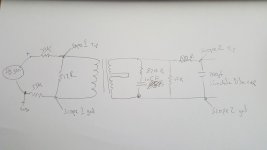
This gave me a fantastic trace ( i think) but the bandwidth suffers a bit starting to reduce from 35khz. But it does seem to be the full output or close as.
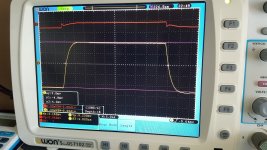
However, Im still not convinced Im testing this right. I cant seem to produce a floating balanced input. I have to connect the ground of the scope probe to the bottom of the 12r load resistor or the output does this. I think its to do with the signal generator having a connection to ground. I can see this is why Sy used the balanced soundcard approach but this hasnt worked for me. In fact i think i still had to have that ground reference on probe one even then.
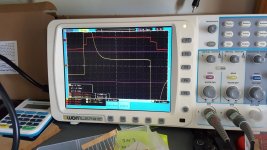
Ive tried putting in a zobel network. I hadnt tried this as the sowter site said specifically its not needed with this transformer.
Tried again with the soundcard approach, this time with my RME UFX but still the ringing was unusable. So went back to this.

This gave me a fantastic trace ( i think) but the bandwidth suffers a bit starting to reduce from 35khz. But it does seem to be the full output or close as.

However, Im still not convinced Im testing this right. I cant seem to produce a floating balanced input. I have to connect the ground of the scope probe to the bottom of the 12r load resistor or the output does this. I think its to do with the signal generator having a connection to ground. I can see this is why Sy used the balanced soundcard approach but this hasnt worked for me. In fact i think i still had to have that ground reference on probe one even then.

I'm thinking of using an ultra low noise preamp 1.1nV/hz opa1642 at x20 for the input.
This could be mounted in the turntable for MC cartridges.
then feed into 6922 to perform RIAA.
best of all worlds as noise levels are SS best and RIAA eq is performed by a tube that can easily drive 10K 300pf cable loads.
This could be mounted in the turntable for MC cartridges.
then feed into 6922 to perform RIAA.
best of all worlds as noise levels are SS best and RIAA eq is performed by a tube that can easily drive 10K 300pf cable loads.
Just had a read through the article,
Gain structure
0.15mV cartridge output
x10 SUT
X73 d3a
Lose 20db (÷10) riaa
X35 6922.
Am I right in thinking you would use 2 x 6922s, one in place of the D3a and hence needing x20 from your opamp?
I think that the noise figure may be a bit misleading. I've just had a look at the data sheet and I can't find any mention of 1.1nV but 5.1nV. You would presumably have extra resistors that add quite a bit of thermal noise and also have negative feedback introduced.
I don't know how significant this is though.
Section 8.2 talks about it being very good for a moving magnet stage.
I think that ss MC stage tend to use discrete stages rather than opamps. Will be interesting to hear how you get on with this idea.
Gain structure
0.15mV cartridge output
x10 SUT
X73 d3a
Lose 20db (÷10) riaa
X35 6922.
Am I right in thinking you would use 2 x 6922s, one in place of the D3a and hence needing x20 from your opamp?
I think that the noise figure may be a bit misleading. I've just had a look at the data sheet and I can't find any mention of 1.1nV but 5.1nV. You would presumably have extra resistors that add quite a bit of thermal noise and also have negative feedback introduced.
I don't know how significant this is though.
Section 8.2 talks about it being very good for a moving magnet stage.
I think that ss MC stage tend to use discrete stages rather than opamps. Will be interesting to hear how you get on with this idea.
- Home
- General Interest
- diyAudio.com Articles
- His Master's Noise: A Thoroughly Modern Tube Phono Preamp